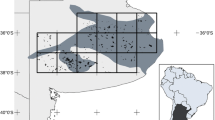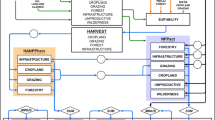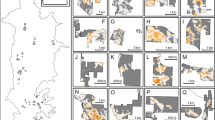Abstract
Land use since 1935 was quantified for Georgia, USA, and for a sample of 20 counties from the major physiographic regions within the state. Statistical data on crop production, pasture productivity, and forest growth were used to estimate net primary production. Appropriate harvest indices (ratio of crop yield to total plant production) were used to correct crop yield data for different decades. Net primary production (NPP) of the Georgia landscape increased from 2.5 to 6.4 tonnes/ha from 1935 to 1982, but varied considerably among land uses and physiographic regions. NPP in the piedmont and mountains reached a plateau between 1960 and 1982, but the upper and lower coastal plains showed a continued linear increase in NPP. In all regions, NPP rose most between 1960 and 1982, coinciding with increases in inputs such as fertilizer and irrigation. Natural ecosystem NPP for Georgia is approximately 16–18 tonnes/ha, and the estimated actual NPP is thus considerably less than the potential. Spatial and temporal patterns of NPP may be a useful basis for evaluating the biological performance of a landscape.
Similar content being viewed by others
Literature cited
Adams, W. E. 1949. Loss of topsoil reduced crop yields.Journal of Soil and Water Conservation 4:130–133.
Austin, R. B., J. Bingham, R. D. Blackwell, L. T. Evans, M. A. Ford, C. L. Morgan, and M. Taylor. 1980. Genetic improvements in winter wheat yields since 1900 and associated physiological changes.Journal of Agricultural Science 94:676–689.
Bond, W. E., and A. R. Spillers. 1935. Use of land for forests in the lower Piedmont region of Georgia. South Forest Experiment Station Occasional Paper 53.
Boring, L. R., and W. T. Swank. 1984. The role of black locust (Robinia pseudoacacia) in forest succession.Journal of Ecology 72:749–766.
Box, E. 1978. Geographical dimensions of terrestrial net and gross primary productivity.Radiation and Environmental Biophysics 15:305–322.
Box, E., H. Lieth, and T. Wolaver. 1971. Miami model productivity map. Reprintedin H. Lieth, Primary production: terrestrial ecosystems.Human Ecology 1:303–332.
Brender, E. V. 1952. From forest to farm to forest again.American Forests 58:24–25, 40–41, and 43.
Brender, E. V. 1974. Impact of past land use on the lower piedmont forest.Journal of Forestry 72:34–36.
Buntley, G. J., and F. F. Bell. 1976. Yield estimates for the major crops grown on soils of west Tennessee. Tennessee Agricultural Experiment Station Bulletin 561.
Cannell, R. Q. 1968. The yielding capacity of cereal crops.Journal of the University Newcastle upon Tyne Agricultural Society 22:3–6.
Chandler, R. F. 1969. Plant morphology and stand geometry in relation to nitrogen. Pages 265–285in J. D. Eastin, F. A. Haskins, C. Y. Sullivan, and C. H. M. Bavel (eds.), Physiological aspects of crop yield. American Society of Agronomists, Madison, Wisconsin.
Clawson, M. 1981. Competitive land use in American forestry and agriculture.Journal of Forest History 25:222–227.
Delcourt, H. R., and W. F. Harris. 1980. Carbon budget of the southeastern US biota: analysis of historical change in trend from source to sink.Science 210:321–323.
Delcourt, H. R., D. C. West, and P. A. Delcourt. 1981. Forests of the southeastern United States: quantitative maps for aboveground woody biomass, carbon, and dominance of major tree taxa.Ecology 62:879–887.
Donald, C. M., and J. Hamblin. 1976. The biological yield and harvest index of cereals as agronomic and breeding criteria.Advances in Agronomy 28:361–405.
Evans, L. T. 1980. The natural history of crop yield.American Scientist 68:388–397.
Falk, J. H. 1980. The primary productivity of lawns in a temperate environment.Journal of Applied Ecology 17:689–696.
Gholz, H. L., and R. F. Fisher. 1982. Organic matter production and distribution in slash pine (Pinus elliottii) plantations.Ecology 63:1827–1839.
Harris, W. F., D. Santantonio, and D. McGinty. 1980. The dynamic belowground ecosystem. Pages 119–129in R. H. Waring (ed.), Forests: fresh perspectives from ecosystem analysis. Proceedings of the 40th Biology, Colloquism. Oregon State University Press, Corvallis, Oregon.
Hartman, W. A., and H. H. Wooten. 1935. Georgia land use problems. Georgia Experiment Station Bulletin 191.
Healy, R. G. 1985. Competition for land in the American South. Conservation Foundation, Washington, DC.
Johnson, W. C., and D. M. Sharpe. 1976. An analysis of forest dynamics in the north Georgia piedmont.Forest Science 22:307–322.
Langdale, G. W., J. E. Box, Jr., R. A. Leonard, A. P. Barnett, and W. G. Fleming. 1979. Corn yield reductions on eroded southern Piedmont soils.Journal of Soil and Water Conservation 34:226–228.
Larson, W. E., F. J. Pierce, and R. H. Dowdy. 1983. The threat of soil erosion to long-term crop production.Science 219:458–465.
Lieth, H. 1972.Uber die Primarproduktion der Pflanzendeck der Erde.Zietschrift für angewandte Botanik 46:1–37.
Lieth, H., and E. Box. 1972. Evapotranspiration and primary productivity.Publications in Climatology 25:37–46.
Melillo, J. M. 1984. Net primary production, net ecosystem production, and nutrient availability. Pages 95–110in Options Mediterraneennes Ciheam IAMZ 1984-I. Workshop Agroecology, Zaragoza, Spain.
Mitchell, R. 1984. The ecological basis for comparative primary production. Pages 13–53in R. Lowrance, B. R. Stinner, and G. J. House (eds.), Agricultural ecosystems. John Wiley and Sons, New York.
Monk, C. 1966. Ecological importance of root/shoot ratios.Bulletin of the Torrey Botanical Club 93:402–406.
Nelson, T. C. 1957. The original forests of the Georgia piedmont.Ecology 38:390–396.
Nemeth, J. C. 1973. Dry matter production in young loblolly and slash pine plantations.Ecological Monographs 43:21–41.
Olson, J. S. 1975. Productivity of forest ecosystems. Pages 33–45in Productivity of world ecosystems. National Academy of Sciences, Washington, DC.
Pimentel, D. 1984. Energy flows in agricultural and natural ecosystems. Pages 125–136in Options Mediterraneennes Ciheam IAMZ 1984-I. Workshop Agroecology, Zaragoza, Spain.
Plucknett, D. L., and N. J. H. Smith. 1986. Sustaining agricultural yields.BioScience 36:40–45.
Plummer, G. L. 1975. 18th century forests in Georgia.Bulletin of the Georgia Academy of Science 33:1–19.
Pomeroy, L. R., W. M. Darley, E. L. Dunn, J. L. Gallagher, E. B. Haines, and D. M. Whitney. 1980. Primary production. Pages 36–67in L. R. Pomeroy and R. G. Wiegert (eds.), The ecology of a salt marsh. Springer, New York.
Risser, P. G., J. R. Karr, and R. T. T. Forman. 1984. Landscape ecology: directions and approaches. Illinois Natural History Survey Special Publication 2, Champaign, Illinois.
Scarsbrook, C. E., and B. D. Doss. 1973. Leaf area index and radiation as related to corn yield.Agronomy Journal 65:459–461.
Sharp, D. D., H. Leith, and D. Whigham. 1975. Assessing regional productivity in North Carolina. Pages 131–146in H. Leith and R. H. Whittaker (eds.), Primary productivity of the biosphere. Springer, New York.
Sharp, D. D., H. Lieth, G. R. Noggle, and H. D. Gross. 1976. Agricultural and forest primary productivity in North Carolina 1972–1973. North Carolina Agricultural Experiment Station Technical Bulletin 241.
Sharpe, D. M. 1975. Methods of assessing the primary production of regions. Pages 147–166in H. Lieth and R. H. Whittaker (eds.), Primary productivity of the biosphere. Springer, New York.
Sharpe, D. M., and W. C. Johnson. 1981. Land use and carbon storage in Georgia's forests.Journal of Environmental Management 12:221–233.
Sims, H. J. 1963. Changes in the hay production and the harvest index of Australian varieties.Australian Journal of Experimental Agriculture and Animal Husbandry 3:198–202.
Singh, I. D., and N. C. Stoskopf. 1971. Harvest index in cereals.Agronomy Journal 63:224–226.
Stearns, F., N. Kobriger, G. Cottam, and E. Howell. 1971. Productivity profile of Wisconsin. Deciduous Forest Biome Memo Report 71-14.
Stewart, O. C. 1956. Fire as the first great source employed by man. Pages 115–184in W. L. Thomas (ed.), Man's role in changing the face of the earth. University of Chicago Press, Chicago.
Tangley, L. 1986. Crop productivity revisited.BioScience 36:142–147.
USDA. 1984. Agricultural statistics. US Government Printing Office, Washington, DC.
USDA, Forest Service. 1978. Forest statistics of the United States, 1977. Washington, DC.
USDA, Forest Service. 1979. A report to Contress on the nation's renewable resources: RPA assessment and alternative program directions; an assessment of the forest and rangeland situation in the US; alternative program directions, 1981–2030. Washington, DC.
USDA, Soil Conservation Service. 1984. National resource inventory, 1982. Washington, DC. Unpublished.
Van Dobben, W. H. 1962. Influence of temperature and light conditions on dry matter distribution, rate of development, and yield in arable crops.The Netherlands Journal of Agricultural Science 10:377–389.
Vogel, O. A., R. E. Allen, and C. J. Peterson. 1963. Plant performance characteristics of semi-dwarf winter wheats producing most efficiently in eastern Washington.Agronomy Journal 55:397–398.
Waring, R. H., and W. H. Schlesinger. 1985. Forest ecosystems, concepts and management. Academic Press, New York.
Author information
Authors and Affiliations
Rights and permissions
About this article
Cite this article
Turner, M.G. Land use changes and net primary production in the Georgia, USA, landscape: 1935–1982. Environmental Management 11, 237–247 (1987). https://doi.org/10.1007/BF01867202
Issue Date:
DOI: https://doi.org/10.1007/BF01867202




